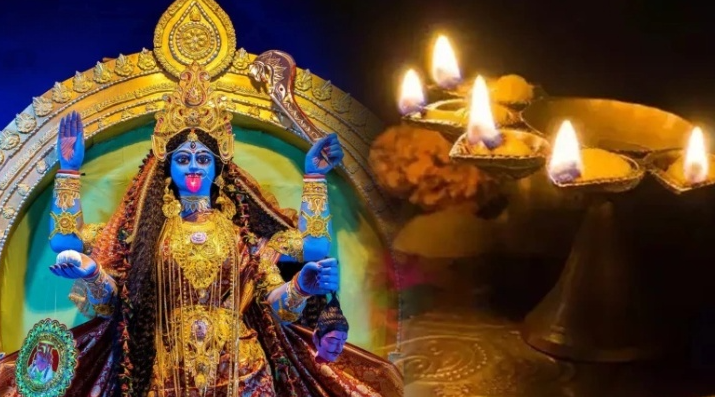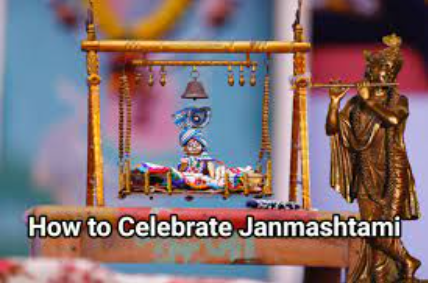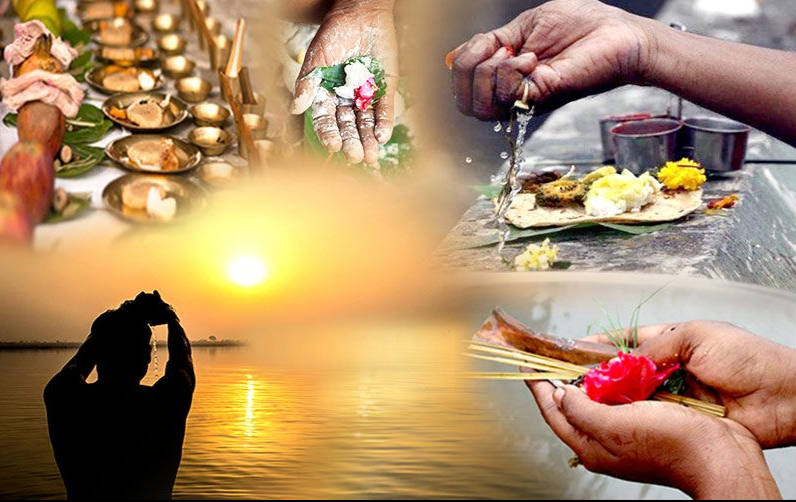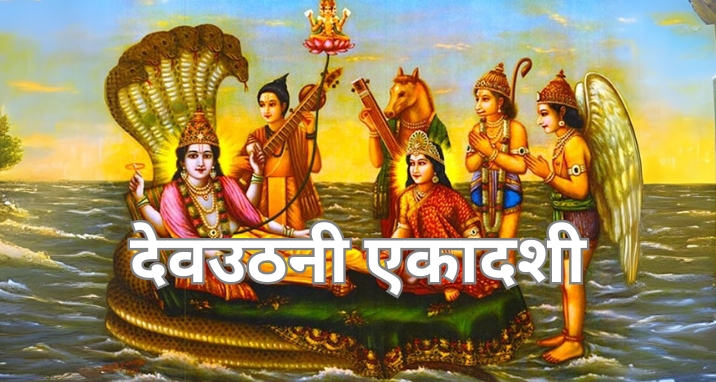Kali Puja: Significance, Tithi and Vidhi!

Kali Puja is dedicated to Goddess Kali, lovingly called Maa Kali by her devotees. She is another form of Maa Durga and is also worshipped during Navratri in the form of Maa Kalratri. Three other major Kali Pujas are Ratanti Kali Puja, Phalaharini Kali Puja and Kaushiki Amavasya Kali Puja. However, the Kali Puja that is celebrated during Deepawali is the most popular one and is known as Dipanwita Kali Puja, celebrated on the new moon day (Amavasya) of the Sanatan Hindu Calendar month of Kartik (that is October or November in the English calendar).
This Kali Puja is majorly celebrated in Eastern Indian states (West Bengal, Odisha, Assam and Jharkhand) with West Bengal being a major place of celebration. While the majority of Indians observe Lakshmi – Ganesh Puja on the Amavasya Tithi, which is the New Moon Day during Diwali, people in West Bengal, Orissa, and Assam worship Maa Kali on the most pivotal day of Diwali festivities—the day of the new moon. Bengali Kali Puja is also known as Shyama Puja, Mahanisha Puja.
Many times Kali Puja is observed a day before Deepavali and many times it is observed on the same day, depending on the Puja tithi. However, this year it falls on the same day that is on November 12, 2023.
Devi Kali is the most fearsome form of Maa Durga. The name of Goddess Kali originates from the Sanskrit term “Kal,” signifying time, which underscores her eternal nature. Her other names include Shyama, Kailka, Chamunda, Shyma Kali, Bhadra Kali, Adya Maa, Tara Maa, and Kaal Nashini.
Devi Kali is shown as a woman with dark skin, 3 eyes, long flowing hair and four hands. The topmost left hand of the Maa holds a sword. The left hand on the bottom carries the mastak or slaughtered head of the Asur. Her right-hand makes an Abhay Mudra, which shows protection. Her garland is made up of slaughtered heads.
Kali Puja Significance
Kali Puja is immensely significant. Worshipping Maa on this day helps natives in destroying evils. She blesses them with health, prosperity, and happiness. Even though her appearance is fearsome, she is actually like a mother who will protect her child, like a lioness protecting her cubs.
Astrologically, this day is associated with the symbolism of life’s shadowy aspects. The worship of Goddess Kali on this particular day is thought to mitigate the adverse influences in one’s life that might be attributed to an unfavourable positioning of Rahu. The worship of Kali symbolises the victory of good over evil, wisdom over ignorance and light over darkness.
Individuals grappling with significant challenges arising from the malefic effects of Rahu are encouraged to perform remedial actions to alleviate these difficulties and seek relief.
The day serves as a powerful reminder of the perpetual struggle between good and evil, underscoring the conviction that goodness and wisdom will always emerge triumphant.
In 2023, the Bengali Kali Puja will be observed on the 12th of November.
Dipanwita Kali Puja 2023 Tithi
Diwali Puja and Kali Puja generally coincide. However, there are instances when Kali Puja takes place a day ahead. The distinction lies in the timing of observing Amavasya, the New Moon night, with Kali Puja marking it at midnight and Lakshmi Puja identifying it at Pradosh, the evening twilight.
-
Kali Puja is on Sunday, November 12, 2023
-
Kali Puja Nishita Time: 11:39 PM to 12:32 AM, Nov 13 Duration – 00 Hours 53 Mins
-
Amavasya Tithi Begins: 02:44 p.m on November 12, 2023
-
Amavasya Tithi Ends: 02:56 p.m on November 13, 2023
Kail Puja Vidhi
Usually, Kali Puja is done in temples and not in homes. However, people visit temples for worship and some people observe Kali Puja in their homes too, though not widely. In West Bengal and other states where Kali Puja is celebrated enthusiastically, Kali Puja is organised in big pandals apart from Kali Mandirs. Maa Kali idols are made and Puja is performed. People visit pandals for both puja and celebrations.
The Puja Vidhi for worshipping Maa Kali is given below, you can follow that.
-
On the occasion of Kali Puja, devotees engage in a thorough cleaning of their homes and adorn their places of worship.
-
Many observe a Nirjala Vrat, a fast without consuming water.
-
Maa Kali is particularly fond of red hibiscus flowers, and therefore, she is lovingly adorned with vibrant garlands of these blossoms.
-
Sacrificing fruits and vegetables, known as Bali, is a customary practice during the festival.
-
In certain regions, alcohol is offered as part of the Prasad to Maa Kali.
-
The devotees chant the Kali Mantra and recite various bhajans of Maa.
-
This occasion is a time for devotion, celebration, and spiritual remembrance of the powerful goddess.
You must perform the rituals correctly. In case of any confusion, you can speak to expert Pundits and Astrologers at NamoAstro.
Legends of Maa Kali
The story of Maa Kali killing Shambhu and Nishambhu is quite famous. Once upon a time, there were two Asur Shambhu and Nishambhu. They were creating havoc in the Swarga. A battle took place between Devraj Indra and the Asur in which the gods were defeated. At that moment Maa Durga went ferocious and turned to Maa Kali.
After demolishing Asur she becomes impetuous and loses control over her and starts killing humans. To save innocent people Bhagwan Shiva placed himself in front of the goddess.
As soon as she stepped on Lord Shiva’s chest her tongue came out as she realised that she had stepped on her husband (Shiva), She soon conciliated herself and came back to her original form and destruction was stopped. From this momentous day, a picture of Kali is depicted as her foot on Bhagwan Shiva.
Frequently Asked Questions
Q: Are Kali and Mahakali the same?
A: Kali is renowned as one of the most formidable, potent, and intricate goddesses in Hindu mythology. She personifies concepts of death, destruction, and cosmic upheaval.
Mahakali, on the other hand, represents the cosmic manifestation of this goddess. In her Mahakali form, she encapsulates the ultimate truth of the universe and wields the combined power of various deities, symbolised by her ten arms.
Q: What is the Tithi for Kali Chaudas in 2023?
A: Kali Chaudas Date – 11th November 2023
Kali Chaudas Puja Muhurat Time – 11:42 PM to 12:31 AM, Nov 12 (Duration – 00 Hours 49 Mins)
Q: Are Kali Chaudas and Kali Puja the same?
A: No, Kali Chaudas is observed on the Chaturdashi Tithi, while Kali Puja is observed on the Amavasya Tithi. In Kali Puja, Maa Kali is worshipped, but in Kali Chaudas, the god of death, Yama is worshipped. In both festivals, devotees worship by lighting lamps. Kali Chaudas is similar to Naraka Chaturdashi in which people seek blessings from Yamraj to protect them from the sufferings of Naraka (hell).









